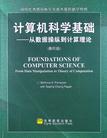计算机科学基础
出版时间:2004-8 出版社:高等教育出版社 作者:(美)弗若赞,(美)费甘 编 页数:384 字数:495000
Tag标签:无
前言
20世纪末,以计算机和通信技术为代表的信息科学和技术对世界经济、科技、军事、教育和文化等产生了深刻影响。信息科学技术的迅速普及和应用,带动了世界范围信息产业的蓬勃发展,为许多国家带来了丰厚的回报。进入21世纪,尤其随着我国加入WTO,信息产业的国际竞争将更加激烈。我国信息产业虽然在20世纪末取得了迅猛发展,但与发达国家相比,甚至与印度、爱尔兰等国家相比,还有很大差距。国家信息化的发展速度和信息产业的国际竞争能力,最终都将取决于信息科学技术人才的质量和数量。引进国外信息科学和技术优秀教材,在有条件的学校推动开展英语授课或双语教学,是教育部为加快培养大批高质量的信息技术人才采取的一项重要举措。为此,教育部要求由高等教育出版社首先开展信息科学和技术教材的引进试点工作。同时提出了两点要求,一是要高水平,二是要低价格。在高等教育出版社和信息科学技术引进教材专家组的努力下,经过比较短的时间,第一批由教育部高等教育司推荐的20多种引进教材已经陆续出版。这套教材出版后受到了广泛的好评,其中有不少是世界信息科学技术领域著名专家、教授的经典之作和反映信息科学技术最新进展的优秀作品,代表了目前世界信息科学技术教育的一流水平,而且价格也是最优惠的,与国内同类自编教材相当。这套教材基本覆盖了计算机科学与技术专业的课程体系,体现了权威性、系统性、先进性和经济性等特点。目前,教育部正在全国35所高校推动示范性软件学院的建设,这也是加快培养信息科学技术人才的重要举措之一。为配合软件学院的教学工作,结合各软件学院的教学计划和课程设置,高等教育出版社近期聘请有关专家和软件学院的教师遴选推荐了一批相应的原版教学用书,正陆续组织出版,以方便各软件学院开展双语教学。
内容概要
进入21世纪,尤其随着我国加入WTO信息产业的国际竞争将更加激烈。我国信息产业虽然在20世纪末取得了迅猛发展,但与发达国家相比,甚至与印度、爱尔兰等国家相比,还有很大的差距。国家信息化的发展速度和信息产业的国际竞争能力,最终都将取决于信息科学技术人才的质量和数量。引进国外信息科学和技术优秀教材,在有条件的学校推动开展英语授课或双语教学,是教育部为加块培养大批高质量的信息技术人才采取的一项重要举措。
作者简介
作者:(美国)弗若赞(Forouzan B.A.) (美国)费甘(Fegan S.C.)
书籍目录
PART I COMPUTER AND DATA 1
Chapter 1 Introduction 2
1.1 The Computer as a Black Box
1.2 von Neumann Model
1.3 Computer Hardware
1.4 Data
1.5 Computer Software
1.6 History
1.7 Key Terms
1.8 Summary
1.9 Practice Set
Chapter 2 Data Representation
2.1 ata Types
2.2 Data inside the Computer
2.3 Representing data
2.4 Hexadecimal Notation
2.5 Octal Notation
2.6 Key Terms
2.7 Summary
2.8 Practice Set
Chapter 3 Number Representation
3.1 Desimal and Binary
3.2 Conversion
3.3 Lnteger Representation
3.4 Excess System
3.5 Floating-Representation
3.6 Hexadecimal Notation
3.7 Key Terms
3.8 Summary
3.9 Practice Set
Chapter 4 Operations On Bits
4.1 Arithmetic Operations
4.2 Logical Operations
4.3 Shift Operations
4.4 Key Terms
4.5 Summary
4.6 Practice Set
PART II COMPUTER HARDWARE
Chapter 5 Computer Organization
5.1 Central Processing Unit(CPU)
5.2 Main Memory
5.3 Input/Output
5.4 Subsystem Interconnection
5.5 Program Execution
5.6 Two Different Architectures
5.7 Key Terms
5.8 Summary
5.9 Practice Set
Chapter 6 Computer Networks
6.1 Networks,Large and Small
6.2 OSI Model
6.3 Categoies of Networks
6.4 Connecting Devices
6.5 The Internet and TCP/IP
6.6 Key Terms
6.7 SUmmary
6.8 practice Set
PART III COMPUTER SOFTWARE
Chapter 7 Operating Systems
7.1 Definition
7.2 Evolution
7.3 Compunents
7.4 Popular Operating Systens
7.5 Key Terms
7.6 SUmmary
7.7 Practice Set
Chapter 8 Algorithms
8.1 Concept
8.2 Three Constructs
8.3 Algorithm Representation
8.4 More Formal Definition
8.5 Subalgorithms
8.6 Basic Algorithms
8.7 Recursion
8.8 Key Terms
8.9 Summary
8.10 Practice Set
Chapter 9 Programming Languages
9.1 Evolution
9.2 Building a Program
9.3 Program Execution
9.4 Categories of Languages
9.5 A Procedural :anguage:C
9.6 Key Terms
9.7 Summary
9.8 Practice Set
Chapter 10 Software Engineering
10.1 Software Life Cycle
10.2 Development Process Models
10.3 Modularity
10.4 Quality
10.5 Documentation
10.6 Key Terms
10.7 Summary
10.8 Practice Set
PART IV DATA ORGANIZATION
Chapter 11 Data Structures
11.1 Arrays
11.2 Resords
11.3 Linked Lists
11.4 Key Terms
11.5 Summary
11.6 Practice Set
Chapter 12 Abstract Data Types
12.1 Background
12.2 Linear Lists
12.3 Stacks
12.4 Queues
12.5 Trees
12.6 Binary Trees
12.7 Graphs
12.8 Key Terms
12.9 Summary
12.10 Practice Set
Chapter 13 File Structuers
13.1 Acdess Methods
13.2 Sequential Files
13.3 Indexed Files
13.4 Hashed Files
13.5 Text versus Binary
13.6 Key Terms
13.7 Summary
13.8 Practice Set
Chapter 14 Databases
14.1 Database Management System
14.2 Auchitecture
14.3 Database Models
14.4 Relatioang Model
14.5 Operations Relations
14.6 Structured Query Language
14.7 Other Database Models
14.8 Key Terms
14.9 Summary
14.10 Practice Set
PART V ADVANCED TOPICS
Chapter 15 Data Compression
15.1 Lossless Compression
15.2 Lossy Compression Methods
15.3 Key Terms
15.4 Summary
15.5 Practice Set
Chapter 16 Security
16.1 Privacy
16.2 Digital Signature
16.3 Key Terms
16.4 Summary
16.5 Practice Set
Chapter 17 Theory Computation
17.1 Simple Languge
17.2 turing Machine
17.3 Godel Numbers
17.4 Halting Problem
17.5 Solvable and Unsolvable Problems
17.6 Key Terms
17.7 Summary
17.8 practic Set
章节摘录
版权页: 插图: preface Welcome to computer science!You are about to start the exploration of a wonderful andexciting world that offers many challenging and exciting careers.Computers play a largepart in our everyday lives and will continue to do so in the future. Computer science is a young discipline that is evolving and progressing.Computer net works have connected people from far flung points of the globe.Virtual reality is creatingthree.dimensional images that amaze the eyes.Space exploration owes part of its success to computers.Computer created special effects have changed the movie industry.And comouters have olaved imoortant roles in zenetics. 1. Input first data item into memory. 2.Input second data item into menmory. 3.Add the tow together and store the result in memory. 4.Output the result. Program Figure 1.7 Program made of instructions combines these instructions to make any number of programs.Each program can be adifferent combination of different instructions. ALGORITHMS The previous requirement made programming possible,but it brought another dimension to using a computer.A programmer must not only learn the hask done by eachinstruction but also lealn how to combine these instructions to do a particular task.Looking at this issue differenfly,a programmer should first solve the problem in a stepbystep manner and then try to find the appropriate instruction(or serles of instructions)that solves the problem.The step.bvstep solution is called an algorithm.Algorithms play a very important role in computer science and are discussed in Chapter 8. LANGUAGES At the beginning of the computer age,there was no computer language.Programmerswrote instructions(using binary patterns)to solve a problem.However,as programsbecame larger,writing long programs using these patterns became tedious.Computerscientists carrie up witll the idea of using symbols to represent binary patterns,iust aspeople use symbols(words)for commands in daily life.But of course,the symbolsused in daily life are different from those used in computers.So the concept of computer languages was born.A natural language(e.g.,English)is a rich language and hasmany rules to combine words correctly;a computer language,on the other handhas amore limited number of symbols and also a limited number of words.You will studycomputer languages in Chapter 9.
编辑推荐
《国外优秀信息科学与技术系列教学用书•计算机科学基础:从数据操纵到计算理论(影印版)》适用于高等院校理工科各专业本科计算机科学导论类课程,对于那些对计算机科学感兴趣的读者而言也有很好的参考价值。
图书封面
图书标签Tags
无
评论、评分、阅读与下载
用户评论 (总计1条)
- 本书对计算机的介绍较为详细,内容也浅显易懂,适于初学者阅读。只是排版不是很好,全英文,读起来较费劲
推荐图书
- C++大学教程
- 计算方法
- 中文版AutoCAD 2006完全实例手册
- 新世纪AutoCAD 2006中文版建筑制图应用教程
- Visual C#.NET案例开发集锦(附光盘)/商业开发代码库系列 (平装)
- AutoCAD 2006中文版机械设计基础
- UG项目式实训教程
- IT企业项目管理:问题.方法和工具
- 机械设计教程与上机实训AutoCAD2006
- 空气洁净技术
- IELTS考试词汇分项突破:口语
- 计算机组装与维修实训教程
- 统一过程最佳实践构造阶段
- 中文版AutoCAD 2006完全学习手册
- 分布式系统概念与设计
- Visual FoxPro管理信息系统毕业设计指导及实例
- 计算机硬件及组成原理
- 神舟飞船系统工程管理
- ATmega128单片机原理与开发指导
- 未来是定数吗?
- 林肯的DNA以及遗传学上的其他冒险
- 全髋全膝关节置换术
- 脑的进化
- 印度的罗摩故事与东南亚文学
- 中国人的赌
